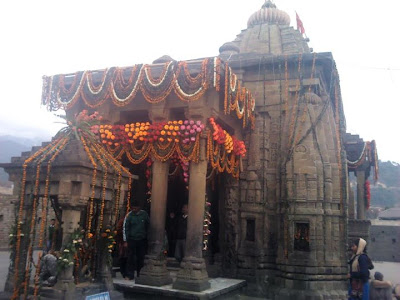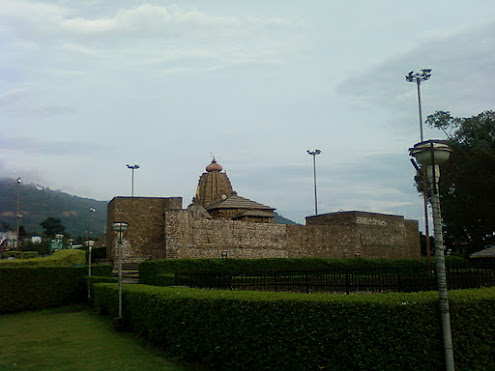The main attraction of Baijnath is an ancient Shiva Temple. According to legend, it is believed that during the Treta Yuga, Ravana invincible powers have worshiped Lord Shiva in the Kailash. In the process, to please the powerful offered his ten heads in Havana kund. Under the affect of this extra ordinary fact of Ravana, Lord Shiva not only restored his heads, but also gave powers of invincibility and immortality.
In this unique gift, Ravana also requested Shiva to accompany him to Lanka. Shiva granted the request of Ravana and converted himself into Shivling.The Lord Shiva asked him to carry the Shivling and told him that he should not place the Shivling down on the ground on his way. Ravana began to move south towards Lanka and reached Baijnath where he felt the need to respond to the call of nature. On seeing a shepherd, Ravana handed over the Shivling to him and went to seek relief from it. On finding the Shivling very heavy, shepherd kept the ling on the ground and the Shivling got established there and the same is in the form of Ardhnarishwar (God in form of Half Male & Half Female).
In the town of Baijnath, Dussehra festival in which traditionally the effigy of Ravana is consigned to the flames is not celebrated as a mark of respect to the devotion of Ravana towards Lord Shiva. Another interesting aspect of the town of Baijnath is that there are no shops of goldsmiths.
History : The history of the ancient Temple of Baijnath is confusing and the two long inscriptions on the walls of the mandapa of the temple gives us account of the temple. The temple was built in Saka 1126 (CE 1204) by two brothers Manyuka and Ahuka in devolution to Lord Vaidyanatha. The inscriptions tell us that a Shivling known as Vaidyanatha already existed in the same place, but was without a home so the present temple and a porch in its front was constructed. British archaeologist Alexander Cunningham has an enrollment of 1786 in the temple, referring to its renovations by King Sansara Chandra. An inscription on the wooden doors of the sanctum of the temple provides the date as samvat 1840 (AD 1783) that is very near to Cunningham’s date. The devastating earthquake that shook the entire region of Kangra, on April 4, 1905 also caused damage to the sanctuary, which has been informed by Mr. J. Ph. Vogel and has since been repaired. Today the temple is a protected monument under the Archaeological Survey of India, but the performance of worship and rituals are conducted by a local council in Baijnath with SDM as its Chairman. The hereditary priests continue to receive a portion of the offerings.
In this unique gift, Ravana also requested Shiva to accompany him to Lanka. Shiva granted the request of Ravana and converted himself into Shivling.The Lord Shiva asked him to carry the Shivling and told him that he should not place the Shivling down on the ground on his way. Ravana began to move south towards Lanka and reached Baijnath where he felt the need to respond to the call of nature. On seeing a shepherd, Ravana handed over the Shivling to him and went to seek relief from it. On finding the Shivling very heavy, shepherd kept the ling on the ground and the Shivling got established there and the same is in the form of Ardhnarishwar (God in form of Half Male & Half Female).
In the town of Baijnath, Dussehra festival in which traditionally the effigy of Ravana is consigned to the flames is not celebrated as a mark of respect to the devotion of Ravana towards Lord Shiva. Another interesting aspect of the town of Baijnath is that there are no shops of goldsmiths.
History : The history of the ancient Temple of Baijnath is confusing and the two long inscriptions on the walls of the mandapa of the temple gives us account of the temple. The temple was built in Saka 1126 (CE 1204) by two brothers Manyuka and Ahuka in devolution to Lord Vaidyanatha. The inscriptions tell us that a Shivling known as Vaidyanatha already existed in the same place, but was without a home so the present temple and a porch in its front was constructed. British archaeologist Alexander Cunningham has an enrollment of 1786 in the temple, referring to its renovations by King Sansara Chandra. An inscription on the wooden doors of the sanctum of the temple provides the date as samvat 1840 (AD 1783) that is very near to Cunningham’s date. The devastating earthquake that shook the entire region of Kangra, on April 4, 1905 also caused damage to the sanctuary, which has been informed by Mr. J. Ph. Vogel and has since been repaired. Today the temple is a protected monument under the Archaeological Survey of India, but the performance of worship and rituals are conducted by a local council in Baijnath with SDM as its Chairman. The hereditary priests continue to receive a portion of the offerings.











